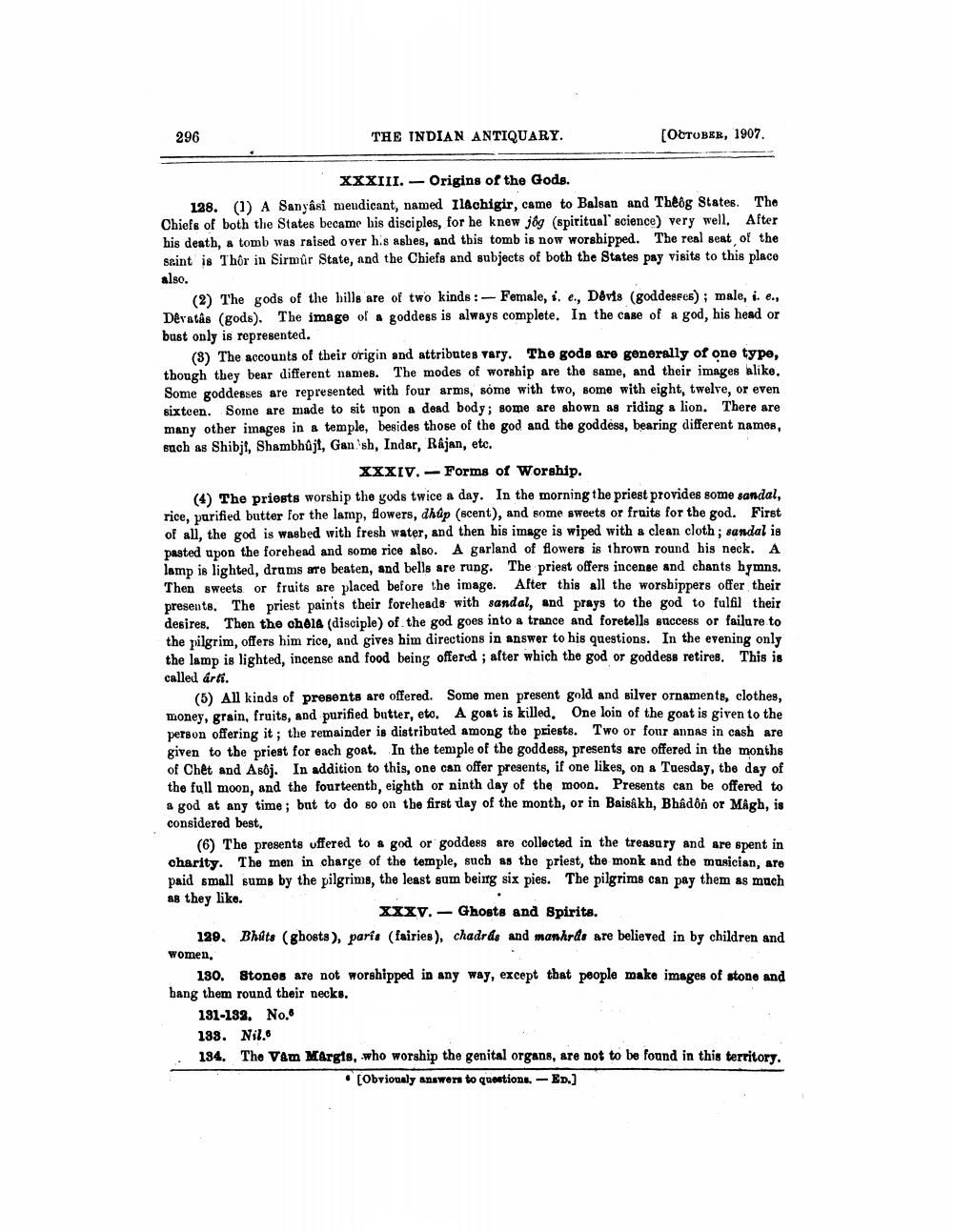________________
296
THE INDIAN ANTIQUARY.
[OCTOBER, 1907.
XXXIII. - Origins of the Gods. 128. (1) A Sanyâsî mendicant, named Il&chigir, came to Balsan and Theog States. The Chiefs of both the States became his disciples, for he knew jog (spiritual science) very well. After his death, a tomb was raised over his ashes, and this tomb is now worshipped. The real seat of the saint is Thộr in Sirmûr State, and the Chiefs and subjects of both the States pay visits to this place also.
(2) The gods of the hills are of two kinds : - Female, i. e., Devis (goddessus); male, i. e., Devatas (gods). The image of a goddess is always complete. In the case of a god, his head or bust only is represented.
(8) The accounts of their origin and attributes vary. The gods are generally of one type, though they bear different names. The modes of worship are the same, and their images alike. Some goddesses are represented with four arms, some with two, some with eight, twelve, or even sixteen. Some are made to sit upon a dead body; some are shown as riding a lion. There are many other images in a temple, besides those of the god and the goddess, bearing different names, such as Shibji, Shambhújt, Gan'sh, Indar, Rajan, etc.
XXXIV. - Forms of Worship. (4) The priests worship the gods twice a day. In the morning the priest provides some sandal, rice, purified butter for the lamp, flowers, dhüp (scent), and some sweets or fruits for the god. First of all, the god is wasbed with fresh water, and then bis image is wiped with a clean cloth ; sandal is pasted upon the forehead and some rice albo. A garland of flowers is thrown round his neck. A lamp is lighted, drums are beaten, and bells are rung. The priest offers incense and chants hymns. Then sweets or fruits are placed before the image. After this all the worshippers offer their presents. The priest paints their foreheade with sandal, and prays to the god to fulfil their desires. Then the chels (disciple) of the god goes into a trance and foretells success or failure to the pilgrim, offers him rice, and gives him directions in answer to his questions. In the evening only the lamp is lighted, incense and food being offered ; after which the god or goddess retires. This is called arti.
(5) All kinds of presents are offered. Some men present gold and silver ornaments, clothes, money, grain, fruits, and purified butter, eto. A goat is killed. One loin of the goat is given to the person offering it; the remainder is distributed among the priests. Two or four annas in cash are given to the priest for each goat. In the temple of the goddess, presents are offered in the months of Chet and Asbj. In addition to this, one can offer presents, if one likes, on a Tuesday, the day of the full moon, and the fourteenth, eighth or ninth day of the moon. Presents can be offered to a god at any time; but to do so on the first day of the month, or in Baisakh, Bhadon or Magh, is considered best.
(6) The presents uffered to a god or goddess are collected in the treasury and are spent in charity. The men in charge of the temple, such as the priest, the monk and the musician, are paid small sums by the pilgrims, the least sum being six pies. The pilgrims can pay them as much as they like.
Xxxy. - Ghosts and Spirits. 129. Bhats (ghosts), paris (fairies), chadrds and manhrds are believed in by children and women,
130. Stonos are not worshipped in any way, except that people make images of stone and bang them round their necks.
131-132. No. 188. Nil. 194. The Vam Margis, who worship the genital organs, are not to be found in this territory.
. [Obviously answer to questions - Ep.)




